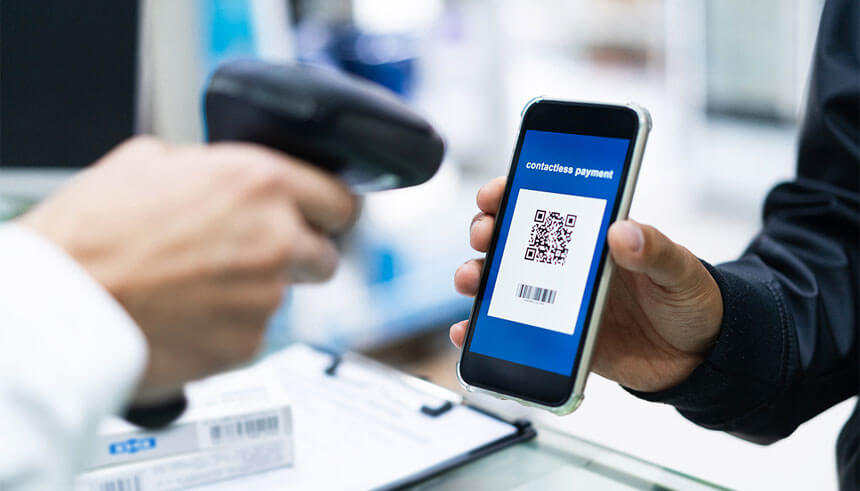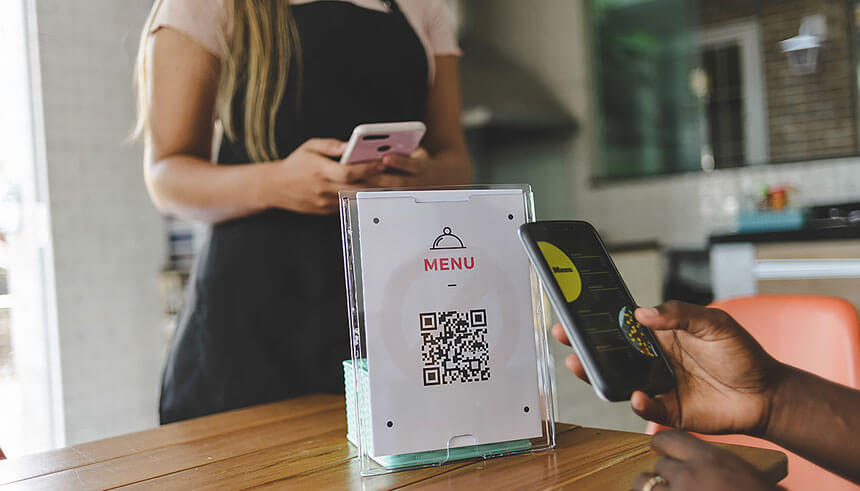Insights
Streamlining Digital Commerce with QR Codes

How QR codes help businesses be more efficient by increasing customer engagement, providing a convenient way to pay and a powerful marketing tool.
Chances are you had to scan a QR code to either pay at a store or access a digital menu at a restaurant at least once in the last year and half. That‘s because the COVID-19 pandemic has accelerated the use of quick response (QR) codes, a type of barcode that stores information that can be read by a digital device, creating a need for fast, secure, convenient and contactless transactions.
While QR code technology has been around since the ‘90s, when a subsidiary of Toyota invented QR codes to track automobiles throughout the manufacturing process, they gained popularity in the U.S. in the early 2010s with the widespread adoption of smartphones and cameras that could read the codes. But the hype had started fading away—until the global pandemic happened, when QR code technology resurged and came into focus yet again.
According to Mercator Advisory Group’s survey, only 13% of consumers in the U.S. used QR codes on their mobile phones prior to the pandemic. The pandemic has added an additional 11%. Furthermore, 34% of those who were already using QR payment technology reported using it more since March 2020. Compare that to countries such as China, where pre-COVID, roughly two out of three consumers were using QR code payments, with payment platform behemoths Alipay and WeChat Pay using QR code technology as part of their core business.
Pandemic or not, QR codes provide a myriad of benefits to businesses. “From helping merchants connect with customers better by providing them with faster and safer in-store checkout experiences, to serving as a robust marketing tool, QR codes can take businesses to the next level and elevate their online and offline presence,” says Dustin Sullivan, national merchant sales manager at East West Bank.
Where QR codes are being used
QR codes can be used for web links, document access, product identification, loyalty programs and payments. Their advantage is that they hold more information and data than traditional barcodes.
In the last year, many restaurants have turned to technology in an effort to provide customers with more contactless options and prevent the spread of the virus. By scanning a QR code, customers can see menus, order food and pay just by pointing their smartphone at the QR code conveniently located on the table, without having to touch anything or wait for the server.
QR codes can be used to quickly direct customers to a webpage or to a signup form. “So, instead of having customers try and look up the website, it’s just taking them directly to a marked point of a URL without the extra steps, saving them time and energy,” says Sullivan.
QR codes are often used by various retailers for their loyalty programs. These programs usually come in the form of a downloadable app, which can scan QR codes. By scanning a code through an app, customers can collect reward points and get special deals. Big retailers like Starbucks and Target use this feature as part of their marketing strategy to engage customers.
Just recently, the pharmacy chain CVS started offering QR code payments through their partnership with PayPal and Venmo at 8,200 stores throughout the U.S. When checking out, either with a cashier or at a self-checkout kiosk, customers can open their PayPal or Venmo mobile app, click the “Scan” button and then select “Show to Pay” to generate a QR code. The QR code checkout process pulls funds from the customer’s PayPal or Venmo account balance, bank account or from a debit or credit card, similar to online transactions so customers have a safe, secure, quick and convenient way to pay.
QR code innovation
QR codes also are a key feature of Amazon's cutting-edge brick-and-mortar stores, Amazon Go, that provide a checkout-free shopping experience that they coined “Just Walk Out Shopping.” When a customer arrives, they use an app that has a QR code to enter the store. Just Walk Out Technology automatically detects when products are taken from or returned to the shelves, and keeps track of them in a virtual cart. When a customer is done shopping, they can just leave the store, without having to wait in line to checkout. Later, Amazon will send them a receipt and charge their Amazon account with the purchases they made.
Lastly, QR codes have been used by public health agencies for contact tracing in the U.K., Australia, Singapore and South Korea. When customers walk into a venue, they can “check in” by using a QR code that will take them to a Google form or a website that logs who has been there and at what time, along with their contact details. If someone tests positive for COVID-19, other customers will be alerted by the app.
How QR codes benefit merchants and consumers
Since the pandemic has uncovered the need for contactless payments, QR codes provide businesses with inexpensive, convenient, safe, and easy-to-implement ways to provide contactless payment options to customers.
“Touchless payment options, like Venmo, PayPal, and now credit cards that are being linked to your mobile wallet, which are going to be converted into QR codes, have given us the ability to touch and carry one less thing,” says Sullivan. “For instance, when I go for a run, I can load the QR code that is linked to my credit card onto my smartwatch. I don't have to carry my wallet with me. If I want to stop by a store somewhere that can read the QR code, it'll take the direct payment from my watch based on the QR code.”
"Touchless payment options, like Venmo, PayPal, and now credit cards that are being linked to your mobile wallet, which are going to be converted into QR codes, have given us the ability to touch and carry one less thing."

Since QR codes carry so much information, many merchants wonder how safe and secure QR code payment transactions are. “QR codes are safer because the data that is transferred through a QR code is encrypted, making it difficult for hackers to steal,” says Sullivan. As with any other payment method that carries some degree of risk, merchants can take a few extra steps to protect themselves and their customers from fraudsters and to promote safety. Putting QR codes in a place where they cannot be manipulated or replaced by fraudsters is one of them. On the consumer side, shoppers need to make sure that they install the latest updates on their mobile devices.
“We are also seeing technology that has been well adopted overseas—like QR codes—coming to the U.S. All of this means that for merchants to be successful, they must be able to offer a variety of payment options. Cash and/or plastic alone won't do it,” adds Jesse Sandoval, director of GTS global payments at East West Bank.
By offering QR code payments, merchants now can accept new payments methods and transact with customers from different countries. “By having the capability to accept QR code payments, merchants can now accept payments through Alipay or WeChat Pay, which serve as a way for businesses to cater to Chinese tourism and also local shoppers that have accounts in China that they want to use in the U.S.,” says Sullivan.
QR codes also serve as a marketing tool to boost consumer engagement and drive brand awareness. Since QR codes can also embed personalized offers, tailored promotions and special messaging, businesses can use them to incentivize consumers to come in, try a special offer and possibly buy something else, thus increasing business revenue.
“QR codes are a great way to streamline things that are going on with the digital side of your business,” says Sullivan. “When we are talking about payments and website connectivity, it's just one more step in a direction that helps your business to be more efficient and be more contactless. And when it’s more efficient, the more effective and the more profitable your business will be.”
How merchants can accept QR code payments
Setting up QR code payment capabilities is surprisingly easy. Merchants who don’t want to invest in sophisticated point-of-sale machines can instead add software that generates a QR code for each purchase. Smaller merchants can use payment services such as Square or PayPal to generate a QR code and use it on a tablet. Larger merchants and big-box retailers can have QR code displays built into their smart terminals.
“Cash is dying out, and I started to see credit cards in the plastic form being used less and less,” says Sullivan. “The next logical step for merchants who want to get with the times and be part of the latest wave in the evolution of payments would be to offer QR code payment options to their customers.”

